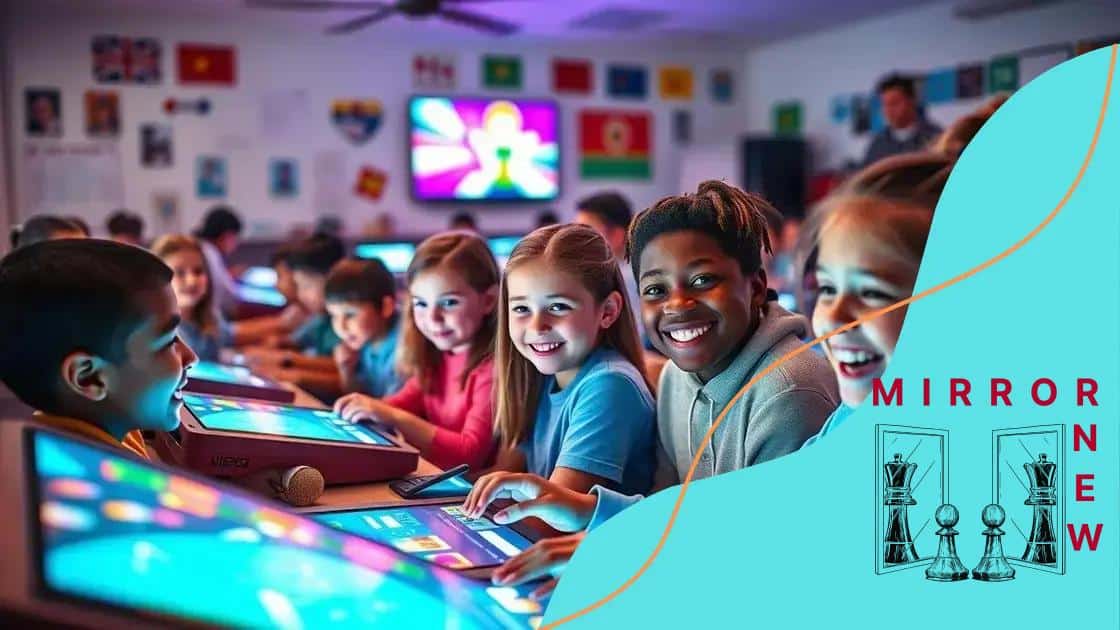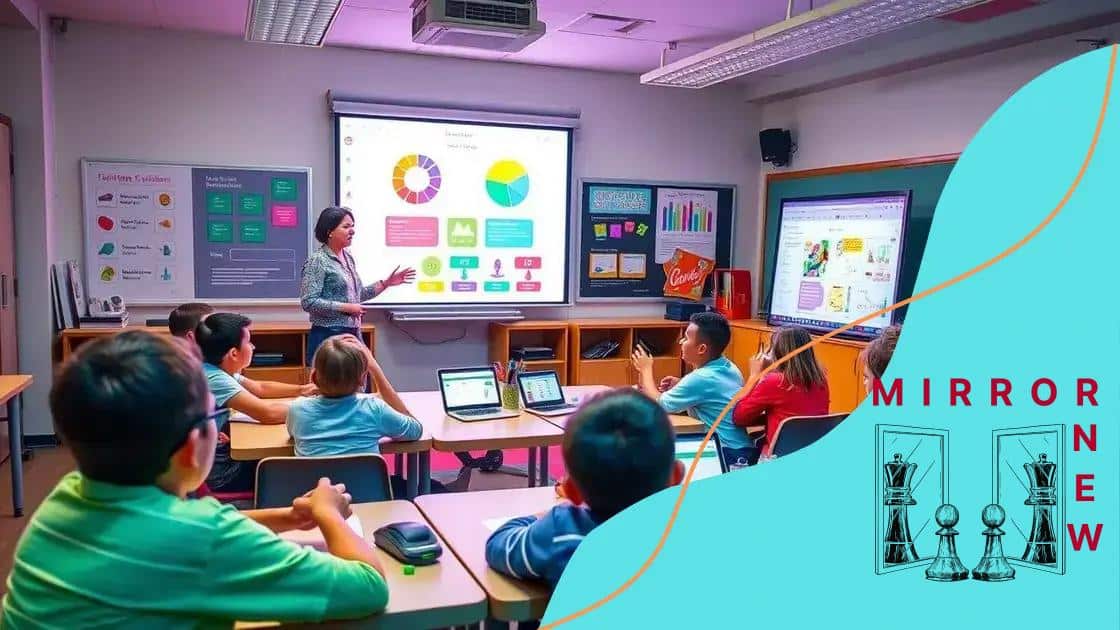Gamified education tools for K-12 schools: engaging students

Gamified education tools for K-12 schools enhance student engagement and learning by incorporating game-like elements, personalized experiences, and technologies like VR and AR.
Gamified education tools for K-12 schools are changing the way students engage with learning materials. Have you ever thought about how game mechanics can make education more exciting and effective? In this article, we’ll explore various tools that bring a playful twist to the classroom.
What are gamified education tools?
Gamified education tools are innovative resources designed to enhance learning through game-like elements. These tools motivate students by incorporating fun and engaging mechanics into educational activities. Instead of traditional teaching methods, these tools create immersive experiences that can improve student participation and retention.
Characteristics of Gamified Tools
These tools often include various features that make learning exciting. They utilize points, badges, and leaderboards to encourage friendly competition and reward accomplishments. By integrating these aspects, educators can create a more dynamic classroom environment.
Types of Gamified Education Tools
- Learning management systems: Platforms like Kahoot! and Quizizz allow teachers to create quizzes and interactive games.
- Simulations: Programs that mimic real-life scenarios, such as coding games or economics simulations.
- Mobile apps: Applications designed for learning on the go, often featuring quizzes and challenges.
Gamified education tools can also aid in developing critical thinking and problem-solving skills. For instance, while playing a math game, students not only practice their math skills but learn to strategize and think critically about their options.
Another important aspect of these tools is feedback. Gamified systems provide immediate responses to students’ actions, enabling them to understand their mistakes and learn from them right away. This instant feedback loop helps learners stay engaged and improves their overall performance.
Benefits of Gamified Learning
Implementing gamified education tools in K-12 settings can lead to numerous benefits. First, they foster a love for learning by making it more interactive and enjoyable. Second, they encourage collaboration among students when they work together to achieve goals in games. Lastly, these tools can appeal to different learning styles, catering to both visual and kinesthetic learners.
Benefits of gamification in K-12 education
Gamification in K-12 education offers various benefits that enhance the learning experience. By incorporating game elements into lessons, teachers can create a more engaging and interactive environment. This approach not only makes learning fun but also motivates students to participate actively in the classroom.
Increased Student Engagement
When students are engaged, they are more likely to learn effectively. Gamification captivates students’ attention and makes them eager to participate. Through interactive elements like competitions and rewards, learners are driven to achieve their goals and excel.
Improved Learning Outcomes
Studies have shown that gamified learning tools can lead to improved academic performance. Students are more inclined to retain information when learning is enjoyable. By incorporating quizzes and games into lessons, teachers can reinforce key concepts and provide instant feedback, which enhances retention.
- Immediate feedback: Students receive quick responses that help them understand their errors.
- Reinforcement: Frequent practice through games solidifies knowledge.
- Motivation: Rewards for achievements boost students’ confidence and inspire further learning.
Another significant aspect of gamification is how it promotes collaboration and teamwork. Many gamified activities involve group participation, encouraging students to work together toward common objectives. This not only fosters social skills but also builds a sense of community in the classroom.
Personalized Learning Experience
The flexibility of gamified tools allows for tailored learning experiences. Students progress at their own pace, which accommodates different learning styles. As they navigate through challenges, they can choose paths that align with their interests and abilities.
Additionally, gamified education tools can highlight areas where students may need extra help. By analyzing overall performance within the game, educators can adapt their teaching strategies to meet individual needs, ensuring all students have the opportunity to succeed.
How to implement gamified tools effectively

Implementing gamified tools effectively in K-12 schools can transform the learning experience. Understanding how to integrate these tools will help educators maximize their benefits. By following a few key strategies, teachers can create an engaging and interactive classroom environment.
Identify Learning Objectives
Before selecting any gamified tools, it’s crucial to define clear learning objectives. Knowing what students should achieve helps in choosing the right tools. Focus on specific skills, whether they are academic, social, or behavioral. This clarity ensures that gamification aligns with your teaching goals.
Select Appropriate Tools
- Research options: Explore various gamified platforms that meet your objectives.
- Test usability: Try out tools to see how user-friendly they are.
- Consider age appropriateness: Choose tools that match the developmental levels of students.
After selecting the right tools, educators should consider how to introduce them to students. It’s essential to explain the goals and rules of the games clearly. Simple instructions encourage participation and excitement. Discuss how students can earn rewards and what behaviors are expected.
Monitor Progress
Once students begin using gamified tools, it’s vital to monitor their progress continuously. Keeping track of students’ achievements helps teachers identify areas needing improvement. Use analytics provided by the tools to gauge comprehension and engagement.
Feedback is another critical element of implementation. Providing timely and constructive feedback encourages students to reflect on their performance. Praise their efforts to foster a positive attitude and motivation. Continuous improvement and encouragement will yield better results.
Encourage Collaboration
Incorporating group activities within gamified learning environments can enhance social skills. Encourage students to work together and share ideas during challenges. Team games promote collaboration, which helps build camaraderie and enhances learning.
Finally, be flexible in your approach. Adjustments may be necessary based on how students respond to the gamified tools. Keeping an open line of communication with students can provide insights into how they feel about the tools in use.
Case studies of successful gamified learning
Case studies of successful gamified learning illustrate the positive impact these tools can have on educational settings. Various schools have adopted gamification strategies, resulting in engaged students and improved learning outcomes. Understanding these examples can help educators envision how to apply similar techniques in their classrooms.
Case Study 1: Kahoot! in the Classroom
One school district implemented Kahoot! to make learning more interactive. Teachers created quizzes on various subjects. Students participated in a fun, competitive environment where they answered questions in real-time. This method led to a noticeable increase in student enthusiasm and participation.
Students reported feeling more motivated to study since they could see immediate results during the games. Their test scores improved, confirming that this gamified approach actively engaged them in their learning process.
Case Study 2: Classcraft for Team Building
Another example is the use of Classcraft, a platform designed to foster collaboration among students. In this case, teachers created an adventure game where students could earn points for good behavior, completing assignments, and helping peers.
- Improved collaboration: Students worked together to achieve goals, fostering a sense of community.
- Behavioral changes: With the point system, students became more motivated to behave well.
- Increased accountability: Group efforts encouraged accountability for one another.
As a result, the classroom environment transformed, with reduced conflicts and enhanced teamwork. Students developed strong relationships as they participated in shared missions.
Case Study 3: Gamification in Language Learning
A language school used a gamified app to teach vocabulary. The app featured challenges and games that made learning engaging and competitive. As students completed levels, they unlocked new content, which sparked excitement.
Teachers noticed a significant increase in vocabulary retention among students. The gamification aspects motivated students to practice more frequently, leading to faster language acquisition.
These case studies showcase how gamified learning tools can create a vibrant and effective learning environment. By observing these success stories, educators can find inspiration to adopt similar methods in their classrooms.
Future trends in gamified education
Future trends in gamified education are shaping the way students learn and interact with educational content. As technology continues to evolve, so do the tools and strategies used in classrooms. Understanding these trends can help educators stay ahead and create engaging learning environments.
Integration of Virtual and Augmented Reality
One major trend is the rise of virtual reality (VR) and augmented reality (AR) in education. These technologies allow students to experience immersive learning. For example, a history lesson could take students on a virtual tour of ancient civilizations. This type of gamified learning engages students and helps them connect with the material on a deeper level.
Adaptive Learning Technologies
Adaptive learning technologies are another significant trend. These systems adjust educational content based on a student’s individual performance. By using data analytics, gamified tools can provide personalized experiences for each learner. This means that if a student struggles with a concept, the tool can offer additional resources or challenges tailored to their needs.
- Personalized pathways: Students progress at their own pace and receive tailored content to address their weaknesses.
- Enhanced feedback: Immediate responses help students understand their mistakes and learn from them.
- Increased motivation: Customized challenges keep students engaged and focused.
These personalized approaches are essential for improving retention and understanding. As educational technology continues to advance, schools must embrace these innovations to keep students engaged.
Gamification Beyond the Classroom
Another trend is the expansion of gamification beyond the classroom.
Extracurricular activities and homelearning can incorporate gamified strategies as well. Students can engage in learning through educational games at home or participate in school-wide competitions. This creates a holistic approach to learning where education blends seamlessly with fun, motivating students further.
By examining these future trends, educators can adapt their teaching methods and tools. This ensures they meet the needs of modern learners and keeps education relevant in the digital age.
Conclusion: Gamified education tools are revolutionizing K-12 learning by making it more engaging and interactive. As these tools evolve, they will incorporate advanced technologies like VR and AR, adapt to individual learning styles, and extend learning beyond the classroom. By understanding and implementing these strategies, educators can create environments that not only motivate students but also enhance their overall learning experiences. The future of education looks bright with gamification leading the way!
FAQ – Frequently Asked Questions about Gamified Education Tools
What are gamified education tools?
Gamified education tools are resources that integrate game-like elements into learning, making education more engaging and interactive.
How can gamification improve student engagement?
Gamification increases student engagement by making learning fun, providing instant feedback, and offering rewards for achieving goals.
What technologies are being used in gamified education?
Technologies like virtual reality (VR) and augmented reality (AR) are increasingly being used to create immersive learning experiences.
Can gamified tools assist with personalized learning?
Yes, gamified tools can adapt to individual learning styles, offering personalized experiences that cater to each student’s needs.





